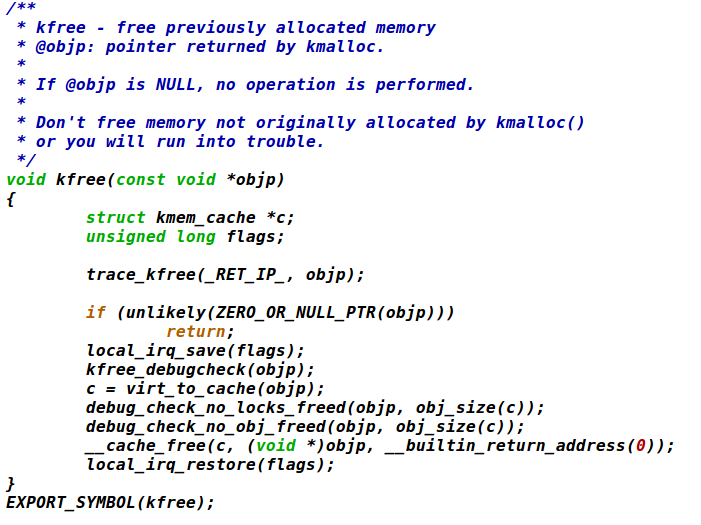Linux字符设备学习,总结
注册字符驱动的一种老方法:
注册一个字符设备的经典方法是使用:
int register_chrdev(unsigned int major, const char *name, structfile_operations *fops);
这里, major 的主编号, name 是驱动的名子(出现在 /proc/devices),
fops file_operations 结构. 一个对 register_chrdev 的调用为给定的主编号注册 0 - 255 的次编号, 并且为每一个建立一个缺省的 cdev 结构。使用这个接口的驱动必须准备好处理对所有 256 个次编号的 open 调用( 不管它们是否对应真实设备 ), 它们不能使用大于 255 的主或次编号。
如果你使用 register_chrdev, 从系统中去除你的设备的正确的函数是:
int unregister_chrdev(unsigned int major, const char *name);
major 和 name 必须和传递给 register_chrdev 的相同, 否则调用会失败.

现在常用的方法,cdev
包含 <linux/cdev.h>, 这个结构和它的关联帮助函数定义在这里.

/**
* cdev_init() - initialize a cdev structure
* @cdev: the structure to initialize
* @fops: the file_operations for this device
*
* Initializes @cdev, remembering @fops, making it ready to add to the
* system with cdev_add().
*/
void cdev_init(struct cdev *cdev, const struct file_operations *fops)
{
memset(cdev, , sizeof *cdev);
INIT_LIST_HEAD(&cdev->list);
kobject_init(&cdev->kobj, &ktype_cdev_default);
cdev->ops = fops;
}
struct cdev 有一个拥有者成员, 应当设置为THIS_MODULE.
一旦 cdev 结构建立, 最后的步骤是把它告诉内核, 调用:
int cdev_add(struct cdev *dev, dev_t num, unsigned int count);
/**
* cdev_add() - add a char device to the system
* @p: the cdev structure for the device
* @dev: the first device number for which this device is responsible
* @count: the number of consecutive minor numbers corresponding to this
* device
*
* cdev_add() adds the device represented by @p to the system, making it
* live immediately. A negative error code is returned on failure.
*/
int cdev_add(struct cdev *p, dev_t dev, unsigned count)
{
p->dev = dev;
p->count = count;
return kobj_map(cdev_map, dev, count, NULL, exact_match, exact_lock, p);
}
这里, dev 是 cdev 结构, dev 是这个设备响应的第一个设备号, count 是应当关联到设备的设备号的数目. 常常 count 是 1
在使用 cdev_add 是有几个重要事情要记住. 除非你的驱动完全准备好处理设备上的操作, 否则你不应当调用 cdev_add。
第一个是这个调用可能失败. 如果它返回一个负的错误码, 你的设备没有增加到系统中.
它几乎会一直成功,但是, 并且带起了其他的点: cdev_add 返回, 你的设备就是"活的",并且内核可以调用它的操作.
从系统去除一个字符设备, 调用:
void cdev_del(struct cdev *dev);
/**
* cdev_del() - remove a cdev from the system
* @p: the cdev structure to be removed
*
* cdev_del() removes @p from the system, possibly freeing the structure
* itself.
*/
void cdev_del(struct cdev *p)
{
cdev_unmap(p->dev, p->count);
kobject_put(&p->kobj);
}
显然, 你不应当在传递给 cdev_del 后存取 cdev 结构。
引入 2 个核心函数来管理 Linux 内核中的内存. 这些函数, 定义
在 <linux/slab.h>, 是:
void *kmalloc(size_t size, int flags);

void kfree(void *ptr);

#define offsetof(TYPE, MEMBER) ((size_t) &((TYPE *)0)->MEMBER) /**
* container_of - cast a member of a structure out to the containing structure
* @ptr: the pointer to the member.
* @type: the type of the container struct this is embedded in.
* @member: the name of the member within the struct.
*
*/
#define container_of(ptr, type, member) ({ \
const typeof( ((type *))->member ) *__mptr = (ptr); \
(type *)( (char *)__mptr - offsetof(type,member) );})
container_of的功能,通过结构体成员的地址,获得结构体的首地址。
以下是简单用法:

Linux字符设备学习,总结的更多相关文章
- linux字符设备学习笔记【原创】
1.申请设备号 int register_chrdev_region(dev_t from, unsigned count, const char *name) 指定从设备号from开始,申请coun ...
- Smart210学习记录----beep linux字符设备驱动
今天搞定了beep linux字符设备驱动,心里还是很开心的,哈哈...但在完成的过程中却遇到了一个非常棘手的问题,花费了我大量的时间,,,, 还是把问题描述一下吧,好像这个问题很普遍的,网上许多解决 ...
- Linux字符设备驱动实现
Linux字符设备驱动实现 要求 编写一个字符设备驱动,并利用对字符设备的同步操作,设计实现一个聊天程序.可以有一个读,一个写进程共享该字符设备,进行聊天:也可以由多个读和多个写进程共享该字符设备,进 ...
- (57)Linux驱动开发之三Linux字符设备驱动
1.一般情况下,对每一种设备驱动都会定义一个软件模块,这个工程模块包含.h和.c文件,前者定义该设备驱动的数据结构并声明外部函数,后者进行设备驱动的具体实现. 2.典型的无操作系统下的逻辑开发程序是: ...
- 深入理解Linux字符设备驱动
文章从上层应用访问字符设备驱动开始,一步步地深入分析Linux字符设备的软件层次.组成框架和交互.如何编写驱动.设备文件的创建和mdev原理,对Linux字符设备驱动有全面的讲解.本文整合之前发表的& ...
- Linux字符设备驱动结构(一)--cdev结构体、设备号相关知识机械【转】
本文转载自:http://blog.csdn.net/zqixiao_09/article/details/50839042 一.字符设备基础知识 1.设备驱动分类 linux系统将设备分为3类:字符 ...
- Linux字符设备中的两个重要结构体(file、inode)
对于Linux系统中,一般字符设备和驱动之间的函数调用关系如下图所示 上图描述了用户空间应用程序通过系统调用来调用程序的过程.一般而言在驱动程序的设计中,会关系 struct file 和 struc ...
- Linux字符设备简单示例
1. Linux字符设备是一种按字节来访问的设备,字符驱动则负责驱动字符设备,这样的驱动通常实现open.close.read和write系统调用.例如:串口.Led.按键等. 2. 通过字符设备文件 ...
- Linux字符设备驱动基本结构
1.Linux字符设备驱动的基本结构 Linux系统下具有三种设备,分别是字符设备.块设备和网络设备,Linux下的字符设备是指只能一个字节一个字节读写的设备,不能随机读取设备内存中某一数据,读取数据 ...
随机推荐
- SQL Server ->> THROW字句对比RAISERROR子句
SQL Server 2012开始引入了THROW字句用于替代从SQL Server开始沿用至今的RAISERROR.既然作用相同,都是在TRY... CATCH代码块后不抓错误然后抛出错误,它们之间 ...
- 关于map容器的元素被无参初始化
使用C++中的map容器定义一个mp,当你执行if语句判断mp[3]是否为1时,那么如果mp[3]以前不存在,此时mp[3]就会被无参初始化,second赋值为0. 以下的程序可以证明这一点.执行了第 ...
- shell-day1
shell概述:这里说的是命令行shell,例如"bash/sh/ksh/csh"(Unix/Linux系统).cmd.exe命令提示字符(windwos系统),这里主要介绍Uni ...
- yii2.0用gii自动补全代码做的简单增删改查,以及图片上传和展示
首先已经用gii根据model层生成了控制器,模型,视图层. 表结构为如图所示:表名为zhoukao1,
- OC NSMutableArray
#import <Foundation/Foundation.h> #import "Student.h" void arrayCreate() { NSMutable ...
- Ubuntu16.04更换NVIDIA驱动导致无法进入图形界面的解决方案
一.进入recovery模式 由于无法进入图形界面,所以需要在开机时进入恢复模式.我的机器上时在开机时通过引导选项中的recovery mode选项进入,进入之后可以看到许多选项卡,选择root,回车 ...
- JavaScript的DOM_节点类型的扩展
DOM 自身存在很多类型,比如 Element 类型(元素节点)再比如 Text 类型(文本节点).DOM 还提供了一些扩展功能. 一.Node类型 Node 接口是 DOM1 级就定义了,Node ...
- 关于Could not obtain transaction-synchronized Session for current thread 这个异常。
Could not obtain transaction-synchronized Session for current thread 这个异常之前非常让我头大.对于网上的各种说法都试了一下反正都不 ...
- BZOJ4887:[TJOI2017]可乐(矩阵乘法)
Description 加里敦星球的人们特别喜欢喝可乐.因而,他们的敌对星球研发出了一个可乐机器人,并且 放在了加里敦星球的1号城市上.这个可乐机器人有三种行为:停在原地,去下一个相邻的 城市,自爆. ...
- tp3.2中前台模板中日期时间的转换
{$vo.create_time|date='Y-m-d',###} 其中###是占位符
